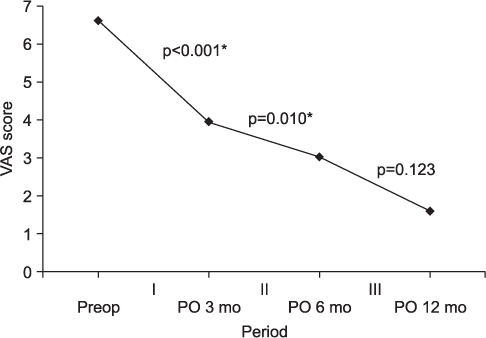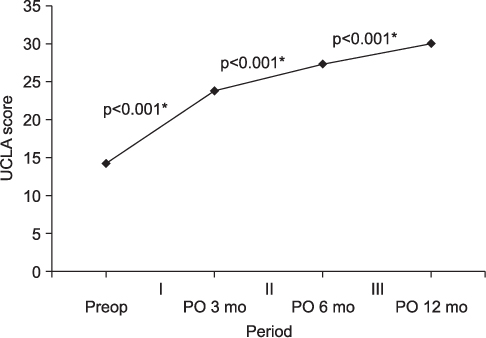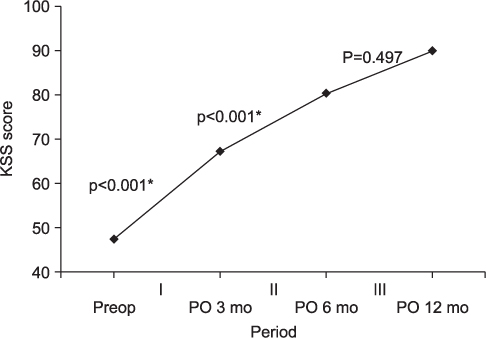J Korean Orthop Assoc.
2013 Aug;48(4):281-289.
When Does the Quality of Life Improve after Rotator Cuff Repair?
- Affiliations
-
- 1Pain Research Center, Department of Orthopedic Surgery, School of Medicine, Keimyung University, Daegu, Korea. oscho5362@dsmc.or.kr
Abstract
- PURPOSE
The purpose of this study was to investigate when the quality of life improve after rotator cuff repair.
MATERIALS AND METHODS
Eighty-five consecutive cases with rotator cuff repair were studied. Patients completed the visual analogue scale (VAS), University of California Los Angeles scale (UCLA), American Shoulder and Elbow Surgeon's scale (ASES), Korean Shoulder scale (KSS), and the World Health Organization Quality of Life Scale abbreviated version (WHOQOL-BREF) preoperatively and at postoperative 3, 6, and 12 months. For evaluation of serial recovery pattern, section I (preoperatively-postoperative 3 months), section II (postoperative 3 months-postoperative 6 months), and section III (postoperative 6 months-postoperative 12 months) were divided.
RESULTS
The mean WHOQOL-BREF score was significantly improved from 58.8 preoperatively to 66.4 at postoperative 12 months, with improvement of VAS, ULCA, ASES, and KSS scores. On serial recovery pattern, all measurements in section I, VAS, UCLA, and KSS scores in section II, and UCLA score in section III, were significantly improved. Female sex had a negative effect on all outcome measurements at postoperative 12 months.
CONCLUSION
Our results showed improvement of quality of life as well as reduced pain and increased function at 3 months after rotator cuff repair. Further recovery of clinical outcomes showed gradual progress until postoperative 12 months.
Keyword
MeSH Terms
Figure
Reference
-
1. Chung SW, Park JS, Kim SH, Shin SH, Oh JH. Quality of life after arthroscopic rotator cuff repair: evaluation using SF-36 and an analysis of affecting clinical factors. Am J Sports Med. 2012; 40:631–639.2. Cho CH, Yeo KK, Lee SY, Jung GH. Mini-open rotator cuff repair using anterolateral approach. J Korean Shoulder Elbow Soc. 2010; 13:86–91.
Article3. Choi CH, Um DH, Kim SK. Pain & motion recovery patterns after rotator cuff repair according to tear size. J Korean Orthop Assoc. 2005; 40:826–831.4. Koo HJ, Cho CH, Jung SW. Psychological status and quality of life in patients with rotator cuff disease. J Korean Soc Biol Ther Psychiatry. 2011; 17:96–103.5. Mohtadi NG, Hollinshead RM, Sasyniuk TM, Fletcher JA, Chan DS, Li FX. A randomized clinical trial comparing open to arthroscopic acromioplasty with mini-open rotator cuff repair for full-thickness rotator cuff tears: disease-specific quality of life outcome at an average 2-year follow-up. Am J Sports Med. 2008; 36:1043–1051.6. Baysal D, Balyk R, Otto D, Luciak-Corea C, Beaupre L. Functional outcome and health-related quality of life after surgical repair of full-thickness rotator cuff tear using a mini-open technique. Am J Sports Med. 2005; 33:1346–1355.
Article7. Charousset C, Grimberg J, Duranthon LD, Bellaïche L, Petrover D, Kalra K. The time for functional recovery after arthroscopic rotator cuff repair: correlation with tendon healing controlled by computed tomography arthrography. Arthroscopy. 2008; 24:25–33.
Article8. Cho CH, Song KS, Jung GH, Lee YK, Shin HK. Early postoperative outcomes between arthroscopic and mini-open repair for rotator cuff tears. Orthopedics. 2012; 35:e1347–e1352.
Article9. Osti L, Papalia R, Paganelli M, Denaro E, Maffulli N. Arthroscopic vs mini-open rotator cuff repair. A quality of life impairment study. Int Orthop. 2010; 34:389–394.
Article10. Prasathaporn N, Kuptniratsaikul S, Kongrukgreatiyos K. Single-row repair versus double-row repair of full-thickness rotator cuff tears. Arthroscopy. 2011; 27:978–985.
Article11. Yoon JP, Oh JH, Min WK, Kim JW, Jeong WJ, Lee HJ. What do the patients want and worry in Korean patients who undergo arthroscopic rotator cuff surgery? Clin Orthop Surg. 2012; 4:278–283.
Article12. Hultenheim Klintberg I, Karlsson J, Svantesson U. Health-related quality of life, patient satisfaction, and physical activity 8-11 years after arthroscopic subacromial decompression. J Shoulder Elbow Surg. 2011; 20:598–608.
Article13. Kim JO, Sim SD, Noh KH, Shon SJ, Kim SJ, Yang YH. Pain recovery pattern according to the integrity after an arthroscopic rotator cuff repair. J Korean Arthrosc Soc. 2009; 13:155–160.14. Cho CH, Jung SW, Son ES, Hwang IS. Sleep status and quality of life in patients with frozen shoulder. J Korean Orthop Assoc. 2012; 47:205–210.
Article15. Lee EH, Kim CJ, Cho SY, Chae HJ, Lee S, Kim EJ. Monitoring the use of health-related quality of life measurements in Korean studies of patients with diabetes. J Korean Acad Nurs. 2011; 41:558–567.
Article16. Lee EH. Instruments for health related quality of life. Korean J Nurs Query. 2007; 16:24–38.17. Brandes M, Ringling M, Winter C, Hillmann A, Rosenbaum D. Changes in physical activity and health-related quality of life during the first year after total knee arthroplasty. Arthritis Care Res (Hoboken). 2011; 63:328–334.
Article18. Quintana JM, Escobar A, Aguirre U, Lafuente I, Arenaza JC. Predictors of health-related quality-of-life change after total hip arthroplasty. Clin Orthop Relat Res. 2009; 467:2886–2894.
Article19. Ellman H, Hanker G, Bayer M. Repair of the rotator cuff. End-result study of factors influencing reconstruction. J Bone Joint Surg Am. 1986; 68:1136–1144.
Article20. Richards RR, An KN, Bigliani LU, et al. A standardized method for the assessment of shoulder function. J Shoulder Elbow Surg. 1994; 3:347–352.
Article21. Tae SK, Rhee YG, Park TS, et al. The development and validation of an appraisal method for rotator cuff disorders: the Korean Shoulder Scoring System. J Shoulder Elbow Surg. 2009; 18:689–696.
Article22. Min SK, Lee CI, Kim KI, Suh SY, Kim DK. Development of Korean version of WHO Quality of life scale abbreviated version (WHOQOL-BREF). J Korean Neuropsychiatr Assoc. 2000; 39:571–579.23. The WHOQOL Group. Development of the World Health Organization WHOQOL-BREF quality of life assessment. Psychol Med. 1998; 28:551–558.24. Ackerman IN, Graves SE, Bennell KL, Osborne RH. Evaluating quality of life in hip and knee replacement: psychometric properties of the World Health Organization Quality of Life short version instrument. Arthritis Rheum. 2006; 55:583–590.
Article25. Oh JH, Jo KH, Kim WS, Gong HS, Han SG, Kim YH. Comparative evaluation of the measurement properties of various shoulder outcome instruments. Am J Sports Med. 2009; 37:1161–1168.
Article
- Full Text Links
- Actions
-
Cited
- CITED
-
- Close
- Share
- Similar articles
-
- Revisional Rotator Cuff Repair
- Sleep disturbances in rotator cuff pathology: insights into mechanisms and clinical implications
- New Retear Pattern after Rotator Cuff Repair at Previous Intact Portion of Rotator Cuff
- Arthroscopic Partial Repair of Massive Contracted Rotator Cuff Tears
- Surgical Options for Failed Rotator Cuff Repair, except Arthroplasty: Review of Current Methods






